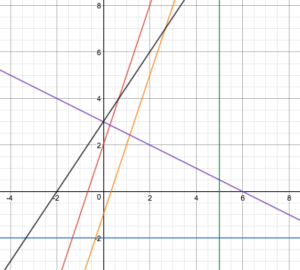Introduction to Equations of Lines
Learning Objectives
Equations of Lines- Write equations of lines in slope-intercept, point-slope, and standard forms
- Identify the equations and graphs of horizontal and vertical lines
- Determine whether two lines are parallel, perpendicular, or neither
- Write equations of lines that are parallel or perpendicular to another line
 (a) [latex]y=3x+2[/latex]
(b) [latex]y-4=-\frac{1}{2}(x+2)[/latex]
(c) [latex]x=5[/latex]
(d) [latex]y=-2[/latex]
(e) [latex]3x=y+1[/latex]
(f) [latex]2y-3x=6[/latex]
(a) [latex]y=3x+2[/latex]
(b) [latex]y-4=-\frac{1}{2}(x+2)[/latex]
(c) [latex]x=5[/latex]
(d) [latex]y=-2[/latex]
(e) [latex]3x=y+1[/latex]
(f) [latex]2y-3x=6[/latex]
Licenses & Attributions
CC licensed content, Original
- Introduction and Learning Objectives. Provided by: Lumen Learning License: CC BY: Attribution.

